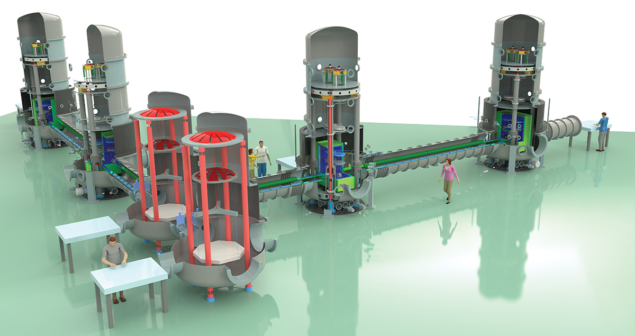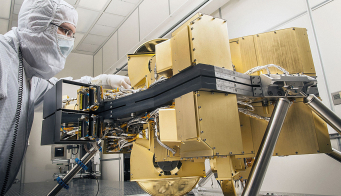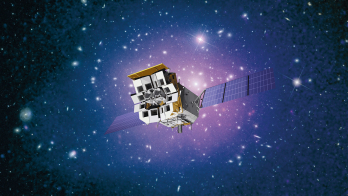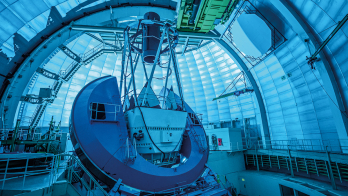Activities are gathering pace at two sites in Europe where the Einstein Telescope, a proposed next-generation gravitational-wave observatory, may be built.

In a former newspaper printing plant in the southern Dutch town of Maastricht, the future of gravitational-wave detection is taking shape. In a huge hall, known to locals as the “big black box”, construction of a facility called ETpathfinder has just got under way, with the first experiments due to start as soon as next year. ETpathfinder will be a testing ground for the new technologies needed to detect gravitational waves in frequency ranges that the present generation of detectors cannot cover. At the same time, plans are being developed for a full-scale gravitational-wave detector, the Einstein Telescope (ET), in the Dutch–Belgian–German border region. Related activities are taking place 1500 km south in the heart of Sardinia, Italy. In 2023, one of these two sites (which have been selected from a total of six possible European locations) will be selected as the location of the proposed ET.
In 2015, the Laser Interferometer Gravitational-Wave Observatory (LIGO), which is based at two sites in the US, made the first direct detection of a gravitational wave. The Virgo observatory near Pisa in Italy came online soon afterwards, and the KAGRA observatory in Japan is about to become the third major gravitational-wave observatory in operation. All are L-shaped laser interferometers that detect relative differences in light paths between mirrors spaced far apart (4 km in LIGO; 3 km in Virgo and KAGRA) at the ends of two perpendicular vacuum tubes. A passing gravitational wave changes the relative path lengths by as little as one part in 1021, which is detectable via the interference between the two light paths. Since 2015, dozens of gravitational waves have been detected from various sources, providing a new window onto the universe. One event has already been linked to astronomical observations in other channels, marking a major step forward in multi-messenger astronomy (CERN Courier December 2017 p17).
Back in time
The ET would be at least 10 times more sensitive than Advanced LIGO and Advanced Virgo, extending its scope for detections and enabling physicists to look back much further in cosmological time. For this reason, the interferometer has to be built at least 200 m underground in a geologically stable area, its mirrors have to operate in cryogenic conditions to reduce thermal disturbance, and they have to be larger and heavier to allow for a larger and more powerful laser beam. The ET would be a triangular laser interferometer with sides of 10 km and four ultra-high vacuum tubes per tunnel. The triangle configuration is equivalent to three overlapping interferometers with two arms each, allowing sources in the sky to be pinpointed via triangulation from just one location instead of several as needed by existing observatories. First proposed more than a decade ago and estimated to cost close to €2 billion, the ET, if approved, is expected to start looking at the sky sometime in the 2030s.

“In the next decade we will implement new technologies in Advanced Virgo and Advanced LIGO, which will enable about a factor-two increase in sensitivity, gaining in detection volume too, but we are reaching the limits of the infrastructure hosting the detectors, and it is clear that at a certain point these will strongly limit the progress you can make by installing new technologies,” explains Michele Punturo of INFN Perugia, who is co-chair of the international committee preparing the ET proposal. “The ET idea and its starting point is to have a new infrastructure capable of hosting further and further evolutions of the detectors for decades.”
Belgian, Dutch and German universities are investing heavily in the ETpathfinder project, which is also funded by European Union budgets for interregional development, and are considering a bid for the ET in the flowing green hills of the border region around Vaals between Maastricht (Netherlands) and Luik (Belgium). A geological study in September 2019 concluded that the area has a soft-soil top layer that provides very good environmental noise isolation for a detector built in granite-like layers 200 m below. Economic studies also show a net benefit, both regional and national, from the high-tech infrastructure the ET would need. But even if ET is not built there, ETpathfinder will still be essential to future gravitational-wave detection, stresses project leader Stefan Hild of Maastricht University. “This will become the testing ground for the disruptive technologies we will need in this field anyway,” he says.
ET in search of home
ETpathfinder is a research infrastructure, not a scale model for the future ET. Its short length means that it is not aimed at detecting gravitational waves at any point in time. The L-shaped apparatus (“Triangulating for the future” image) has two arms about 20 m long, with two large steel suspension towers each containing large mirrors. The arms meet in a central fifth steel optical tower and one of the tubes extends behind the central tower, ending in a sixth tower. The whole facility will be housed in a new climate-controlled clean room inside the hall, and placed on a new low-vibration concrete floor. ETpathfinder is not a single interferometer but consists of two separate research facilities joined at one point for shared instrumentation and support systems. The two arms could be used to test different mirrors, suspensions, temperatures or laser frequencies independently. Those are the parameters Hild and his team are focusing on to further reduce noise in the interferometers and enhance their sensitivity.
Deep-cooling the mirrors is one way to beat noise, says Hild. But it also brings huge new challenges. One is that thermal conductivity of silica glass is not perfect at deep cryogenic temperatures, leading to deformations due to local laser heating. For that reason, pure silicon has to be used, but silicon is not transparent to the conventional 1064 nm laser light used for detecting gravitational waves and to align the optical systems in the detector. Instead, a whole new laser technology at 1550 nm will have to be developed and tested, including fibre-laser sources, beam control and manipulation, and specialised low-noise sensors. “All these key technologies and more need testing before they can be scaled up to the 10 km scales of the future ET,” says Hild. Massive mirrors in pure silicon of metre-sizes have never been built, he points out, nor have silicon wire suspensions for the extreme cold payloads of more than half a tonne. Optoelectronics and sensors at 1550 nm at the noise level required for gravitational-wave detectors are also non-standard.
On paper, the new super-low noise detection technologies to be investigated by ETpathfinder will provide stunning new ways of looking at the universe with the ET. The sensitivity at low frequencies will enable researchers to actually hear the rumblings of space–time hours before spiralling black holes or neutron stars coalesce and merge. Instead of astronomers struggling to point their telescopes at the point in the sky indicated by millisecond chirps in LIGO and Virgo, they will be poised to catch the light from cosmic collisions many billions of light years away.
Archimedes weighs in on the quantum vacuum

The Archimedes experiment, which will be situated under 200 m of rock at the Sar-Grav laboratory in the Sos Enattos mine in Sardinia, was conceived in 2002 to investigate the interaction between the gravitational field and vacuum fluctuations. Supported by a group of about 25 physicists from Italian institutes and the European Gravitational Observatory, it is also intended as a “bridge” between present- and next-generation interferometers. A separate project in the Netherlands, ETpathfinder, is performing a similar function (see main text).
Quantum mechanics predicts that the vacuum is a sea of virtual particles which contribute an energy density – although one that is tens of orders of magnitude larger than what is observed. Archimedes will attempt to shed light on the puzzle by clarifying whether virtual photons gravitate or not, essentially testing the equivalent of Archimedes’ principle in vacuum. “If the virtual photons do gravitate then they must follow the gravitational field around the Earth,” explains principal investigator Enrico Calloni of the University of Naples Federico II. “If we imagine removing part of them from a certain volume, creating a bubble, there will be a lack of weight (and pressure differences) in that volume, and the bubble will sense a force directed upwards, similar to the Archimedes force in a fluid. Otherwise, if they do not gravitate, the bubble will not experience any variation in the force even being immersed in the gravitational field.”
The experiment (pictured) will use a Casimir cavity comprising two metallic plates placed a short distance apart so that virtual photons that have too large a wavelength cannot survive and are expelled, enabling Archimedes to measure a variation of the “weight” of the quantum vacuum. Since the force is so tiny, the measurement must be modulated and performed at a frequency where noise is low, says Calloni. This will be achieved by modulating the vacuum energy contained in the cavity using plates made from a high-temperature superconductor, which exhibits transitions from a semiconducting to superconducting state and in doing so alters the reflectivity of the plates. The first prototype is ready and in March the experiment is scheduled to begin six years of data-taking. “Archimedes is a sort of spin-off of Virgo, in the sense that it uses many of the technologies learned with Virgo: low frequency, sensors. And it has a lot of requirements in common with third-generation interferometers like ET: cryogenics and low seismic noise, first and foremost,” explains Calloni. “Being able to rely on an existing lab with the right infrastructure is a very strong asset for the choice of a site for ET.”
Sardinian adventure
The Sos Enattos mine is situated in the wild and mountainous heart of Sardinia, an hour’s drive from the Mediterranean coast. More than 2000 years ago, the Romans (who, having had a hard time conquering the land, christened the region “Barbaria”) excavated around 50 km of underground tunnels to extract lead for their aqueduct pipes. Until it closed activity in 1996, the mine has been the only alternative to livestock-rearing in this area for decades. Today, the locals are hoping that Sos Enattos will be chosen as the site to host the ET. Since 2010, several underground measurement campaigns have been carried out to characterise the site in terms of environmental noise. The regional government of Sardinia is supporting the development of the “Sar-Grav” underground laboratory and its infrastructures with approximately €3.5 million, while the Italian government is supporting the upgrade of Advanced Virgo and the characterisation of the Sos Enattos site with about €17 million, as part of a strategy to make Sardinia a possible site for the ET.
Sar-Grav’s control room was completed late last year, and its first experiment – Archimedes – will soon begin (see “Archimedes weighs in on the quantum vacuum” panel), with others expected to follow. Archimedes will measure the effect of quantum interactions with gravity via the Casimir effect and, at the same time, provide a testbed to verify the technologies needed by a third-generation gravitational-wave interferometer such as the ET. “Archimedes has the same requirements as an underground interferometer: extreme silence, extreme cooling with liquid nitrogen, and the ensuing safety requirements,” explains Domenico D’Urso, a physicist from the University of Sassari and INFN.
Follow the noise
Sardinia is the oldest land in Italy and the only part of the country without significant seismic risk. The island also has a very low population density and thus low human activity. The Sos Enattos mine has very low seismic noise and the most resistant granitic rock, which was used until the 1980s to build the skyscrapers of Manhattan. Walking along the mine’s underground tunnels – past the Archimedes cavern, amidst veins of schist, quartz, gypsum and granite, ancient mining machines and giant portraits of miners bearing witness to a glorious past – an array of instruments can be seen measuring seismic noise; some of which are so sensitive that they are capable of recording the sound of waves washing against the shores of the Thyrrenian sea. “We are talking about really small sensitivities,” continues Domenico. “An interferometer needs to be able to perform measurements of 10–21, otherwise you cannot detect a gravitational wave. You have to know exactly what your system is doing, follow the noise and learn how to remove it.”
With the Einstein Telescope, we have 50 years of history ahead
The open European ET collaboration will spend the next two years characterising both the Sardinian and Netherlands sites, and then choosing which best matches the required parameters. In the current schedule, a technical design report for the ET would be completed in 2025 and, if approved, construction would take place from 2026 with first data-taking during the 2030s. “As of then, wherever it is built, ET will be our facility for decades, because its noise will be so low that any new technology that at present we cannot even imagine could be implemented and not be limited,” says Punturo, emphasising the scientific step-change. Current detectors can see black-hole mergers occurring at a redshift of around one when the universe was six billion years old, Punturo explains, while current detectors at their final sensitivity will achieve a redshift of around two, corresponding to three billion years after the Big Bang. “But we want to observe the universe in its dark age, before stars existed. To do so, we need to increase sensitivity to a redshift tenfold and more,” he says. “With ET, we have 50 years of history ahead. It will study events from the entire universe. Gravitational waves will become a common tool just like conventional astronomy has been for the past four centuries.”







